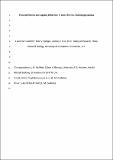Files in this item
Food preference and copying behaviour in zebra finches, Taeniopygia guttata
Item metadata
| dc.contributor.author | Guillette, Lauren | |
| dc.contributor.author | Morgan, Kate | |
| dc.contributor.author | Hall, Zachary Jonas | |
| dc.contributor.author | Bailey, Ida Elizabeth | |
| dc.contributor.author | Healy, Susan Denise | |
| dc.date.accessioned | 2015-05-01T23:01:39Z | |
| dc.date.available | 2015-05-01T23:01:39Z | |
| dc.date.issued | 2014-11 | |
| dc.identifier | 129359212 | |
| dc.identifier | ca7cf01d-6971-4b62-ad5a-7d47bd17ab7c | |
| dc.identifier | 24797456 | |
| dc.identifier | 000347742900006 | |
| dc.identifier | 24797456 | |
| dc.identifier | 84912066813 | |
| dc.identifier.citation | Guillette , L , Morgan , K , Hall , Z J , Bailey , I E & Healy , S D 2014 , ' Food preference and copying behaviour in zebra finches, Taeniopygia guttata ' , Behavioural Processes , vol. 109 , no. Part B , pp. 145-150 . https://doi.org/10.1016/j.beproc.2014.04.013 | en |
| dc.identifier.issn | 0376-6357 | |
| dc.identifier.other | ORCID: /0000-0002-8059-4480/work/60631242 | |
| dc.identifier.uri | https://hdl.handle.net/10023/6618 | |
| dc.description | The authors acknowledge the Royal Society and The British Academy (Newton International Fellowship: L.M.G. NF120136), BBSRCBB/I019502/1 (I.E.B., K.V.M. and S.D.H.) and NSERC and SORSAS (Z.J.H.) for funding. | en |
| dc.description.abstract | As a social species zebra finches might be expected to copy the food choices of more experienced conspecifics. This prediction has been tested previously by presenting observers with two demonstrator birds that differ in some way (e.g., sex, familiarity), each feeding on a different colour food source. However, if the observer subsequently exhibits a preference, it is unclear whether it has copied the choice of one demonstrator or avoided the choice of the other. Furthermore, this choice may actually be influenced by pre-existing preferences, a potential bias that is rarely tested. Here we examine whether apparent copying or avoidance can be explained by pre-existing preferences. In Experiment 1, observers had the opportunity to watch a conspecific forage from one of the two differently coloured food hoppers. In Experiment 2, the observers did not have this opportunity. In both experiments observers were subsequently tested for their food hopper preference and all but one preferred one colour over the other. In Experiment 1 some observers showed evidence for copying, while others seemed to avoid the colour preferred by the demonstrator. In Experiment 2 females generally preferred the white hopper. Pre-existing colour preferences could, therefore, explain the apparent copying/avoidance we observed. This article is part of a Special Issue entitled: Cognition in the wild. | |
| dc.format.extent | 6 | |
| dc.format.extent | 331760 | |
| dc.language.iso | eng | |
| dc.relation.ispartof | Behavioural Processes | en |
| dc.subject | Avoidance | en |
| dc.subject | Colour preference | en |
| dc.subject | Copying | en |
| dc.subject | Food choice | en |
| dc.subject | Social learning | en |
| dc.subject | Zebra finch | en |
| dc.subject | QH301 Biology | en |
| dc.subject.lcc | QH301 | en |
| dc.title | Food preference and copying behaviour in zebra finches, Taeniopygia guttata | en |
| dc.type | Journal article | en |
| dc.contributor.sponsor | The Royal Society | en |
| dc.contributor.sponsor | BBSRC | en |
| dc.contributor.sponsor | BBSRC | en |
| dc.contributor.institution | University of St Andrews. School of Biology | en |
| dc.contributor.institution | University of St Andrews. Institute of Behavioural and Neural Sciences | en |
| dc.contributor.institution | University of St Andrews. Centre for Social Learning & Cognitive Evolution | en |
| dc.contributor.institution | University of St Andrews. School of Psychology and Neuroscience | en |
| dc.contributor.institution | University of St Andrews. Centre for Biological Diversity | en |
| dc.identifier.doi | https://doi.org/10.1016/j.beproc.2014.04.013 | |
| dc.description.status | Peer reviewed | en |
| dc.date.embargoedUntil | 2015-05-02 | |
| dc.identifier.grantnumber | NF120136 | en |
| dc.identifier.grantnumber | BB/I019502/1 | en |
| dc.identifier.grantnumber | BB/I019502/1 | en |
This item appears in the following Collection(s)
Items in the St Andrews Research Repository are protected by copyright, with all rights reserved, unless otherwise indicated.

